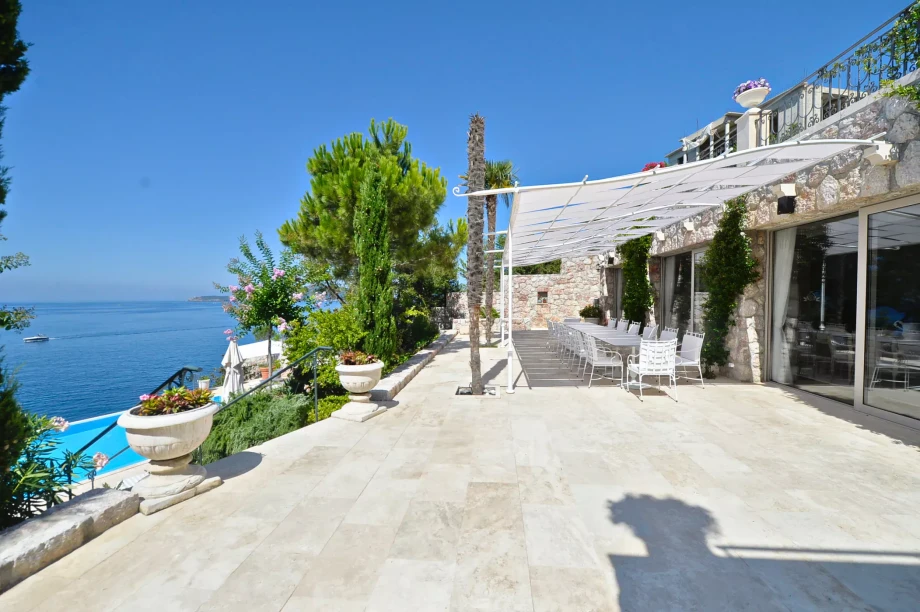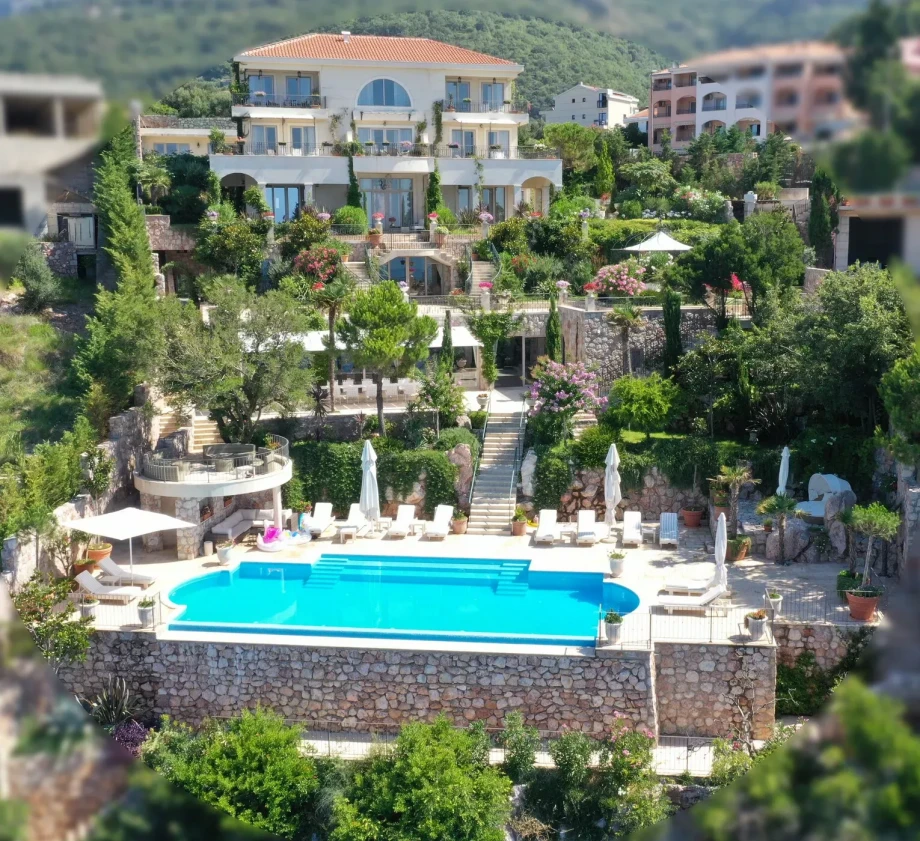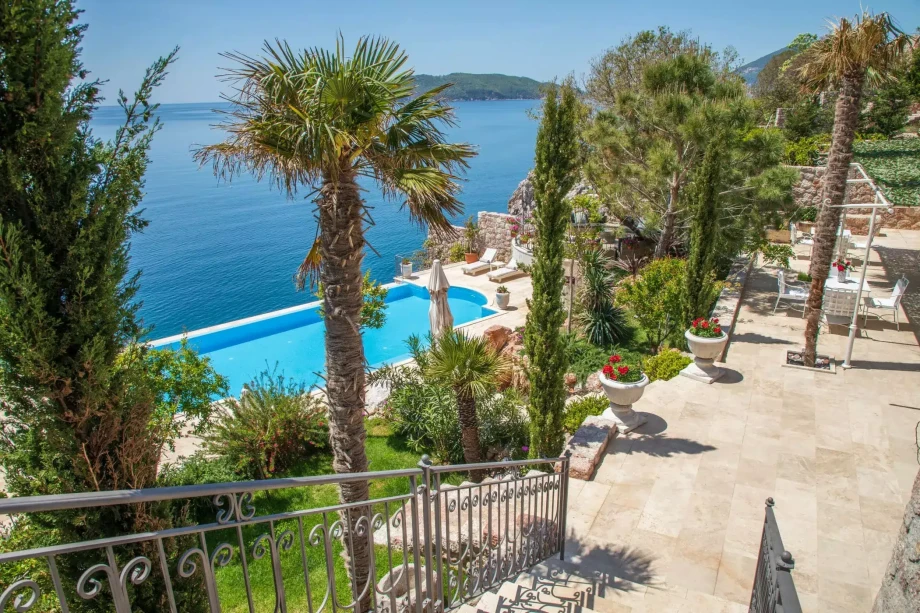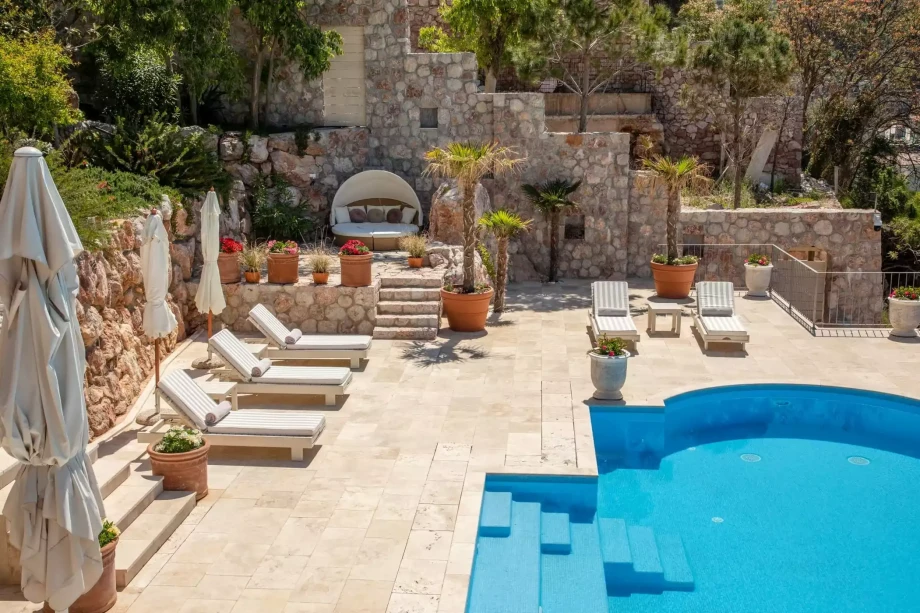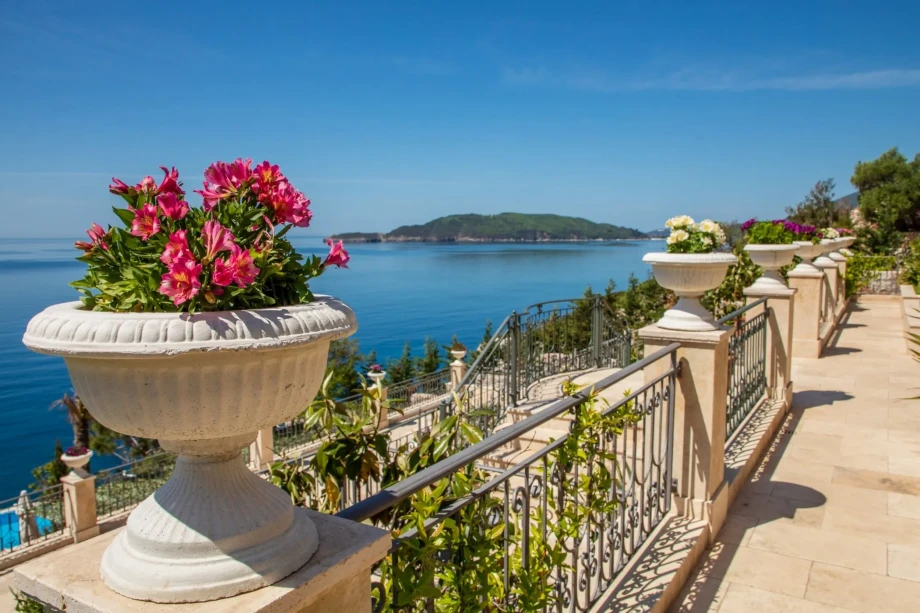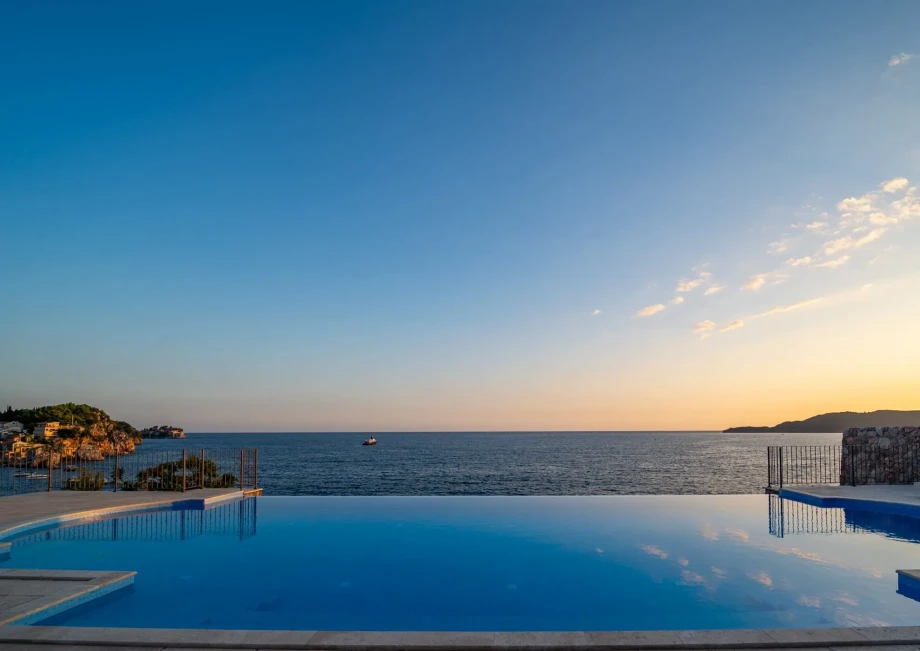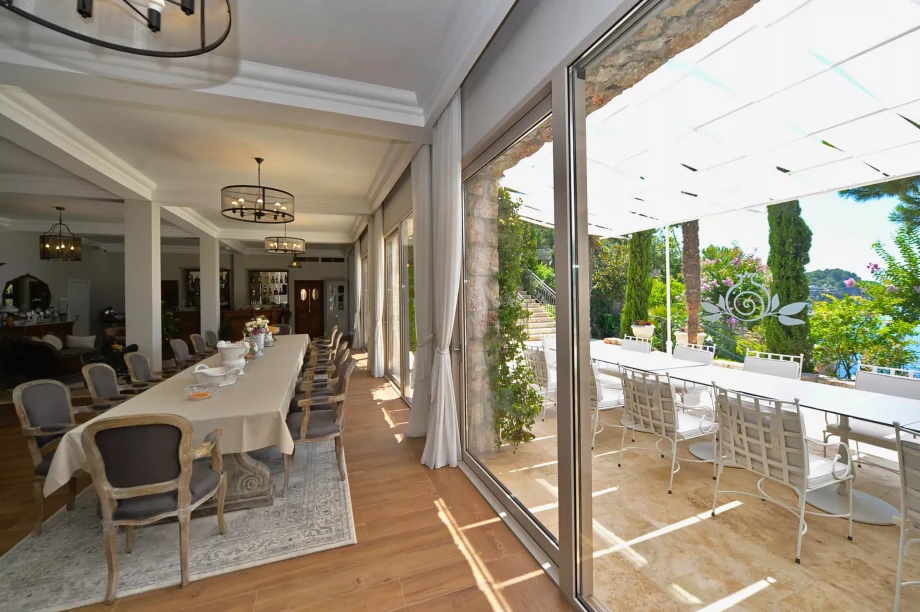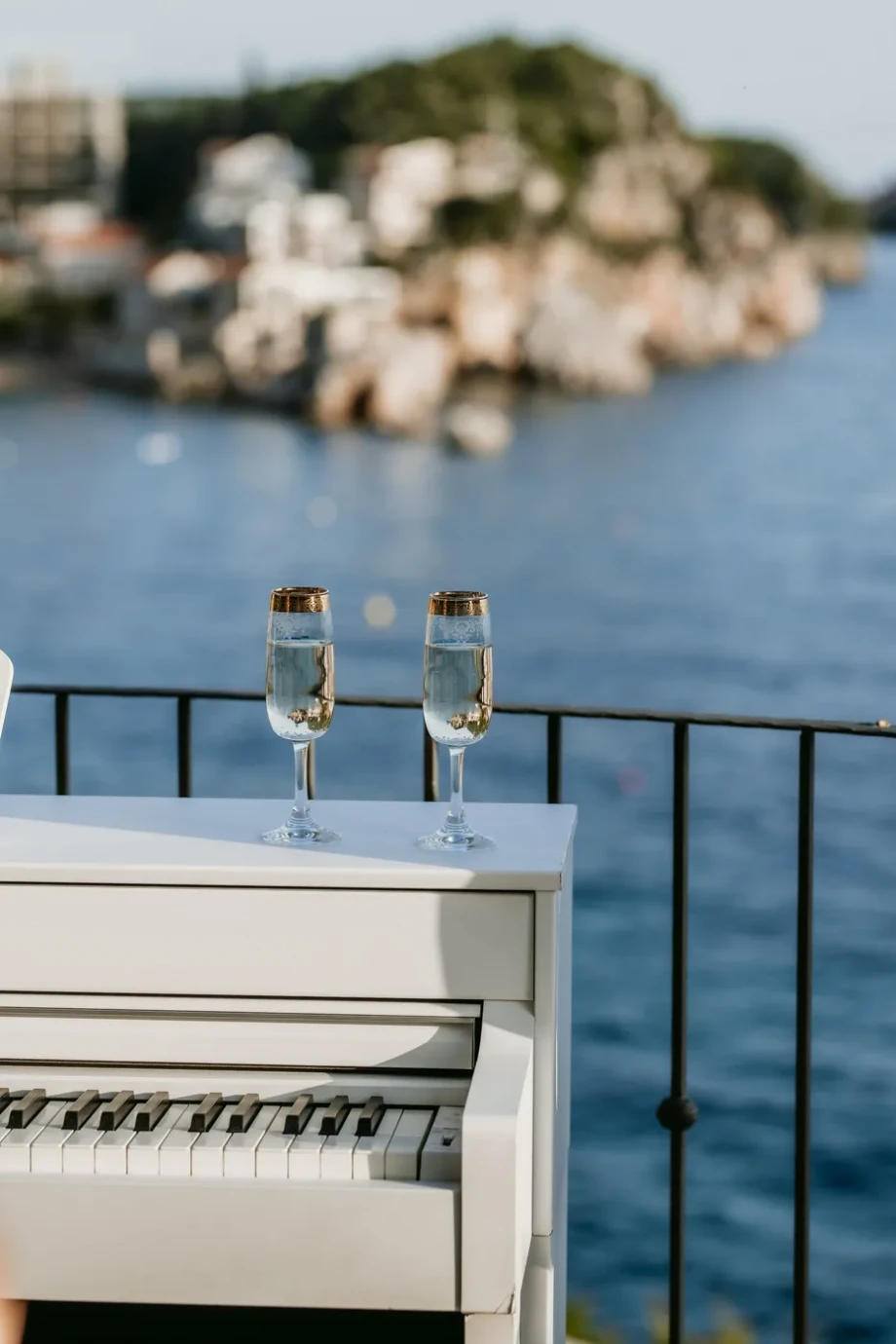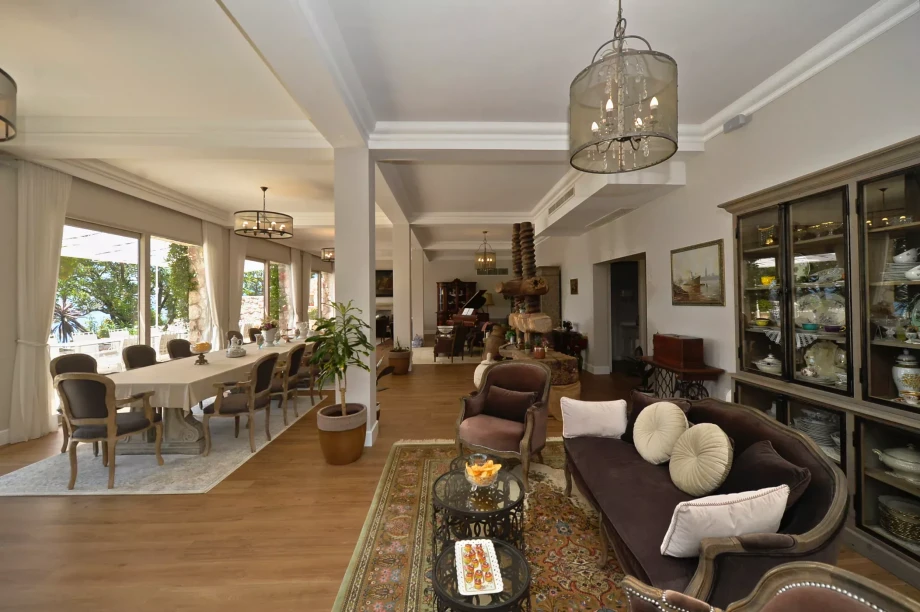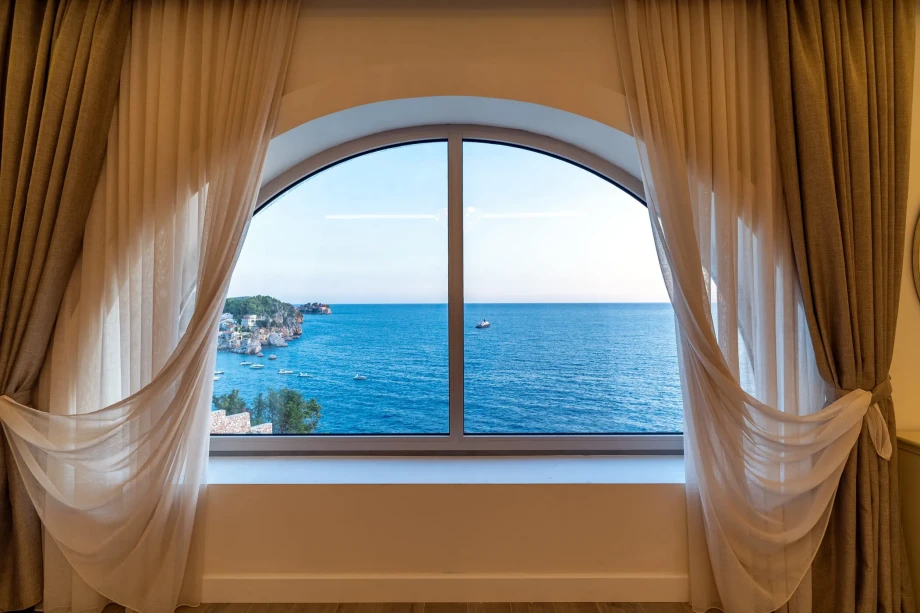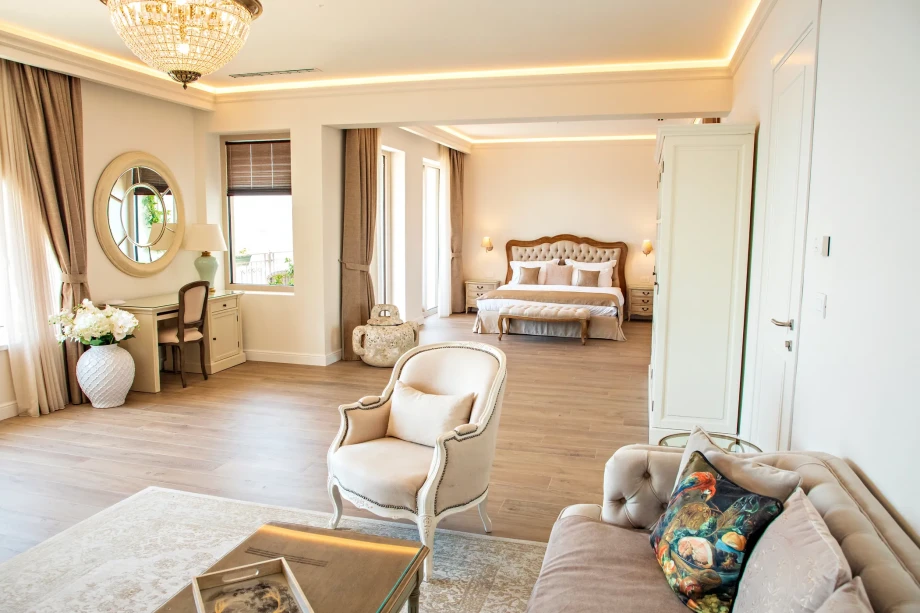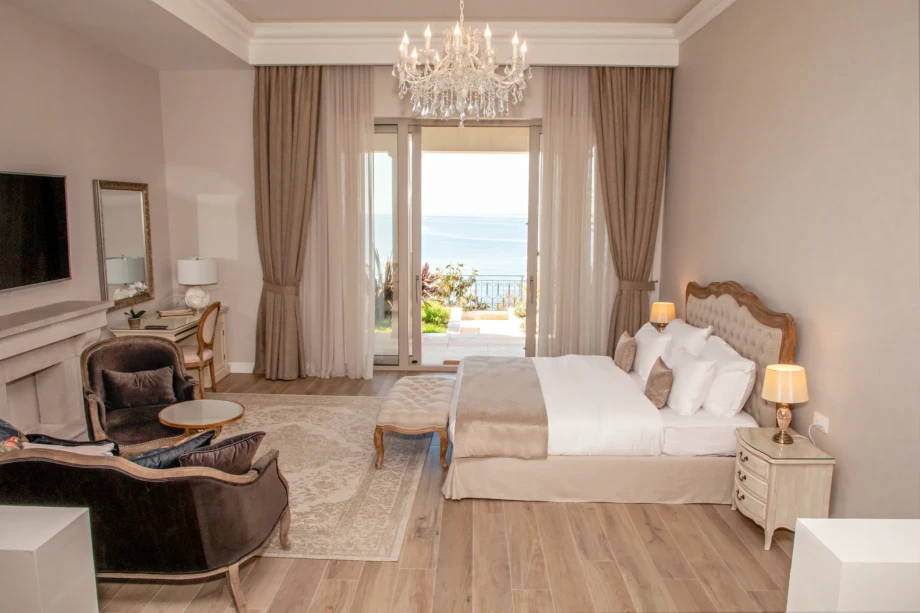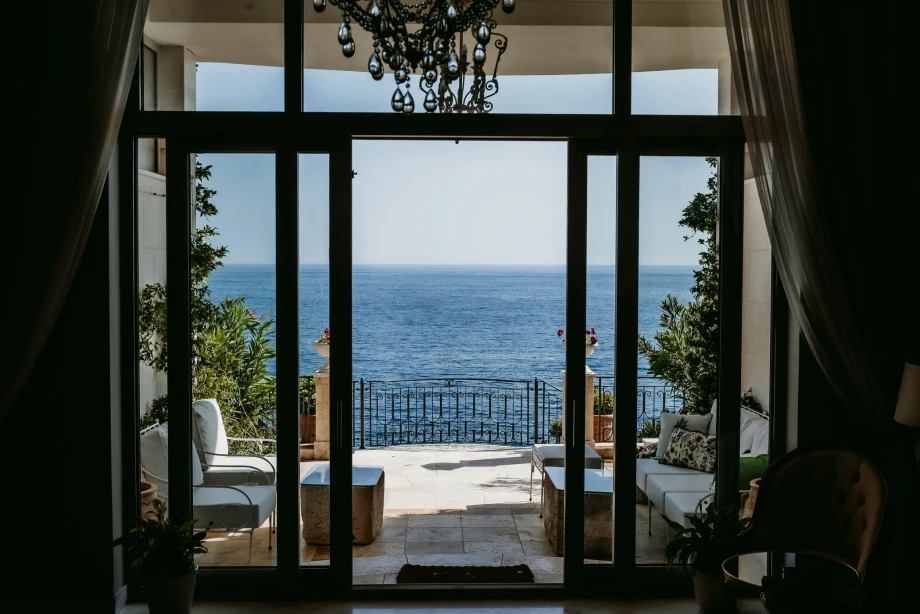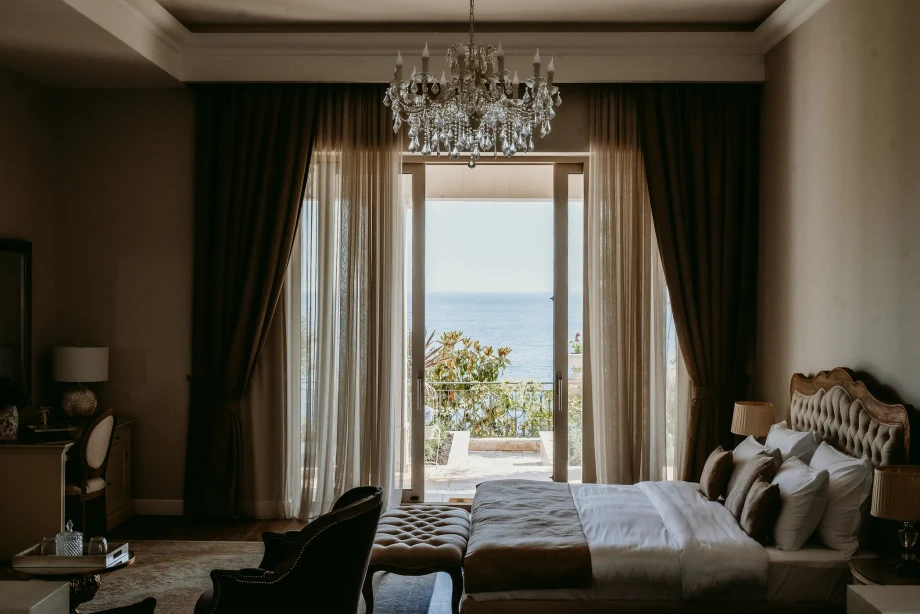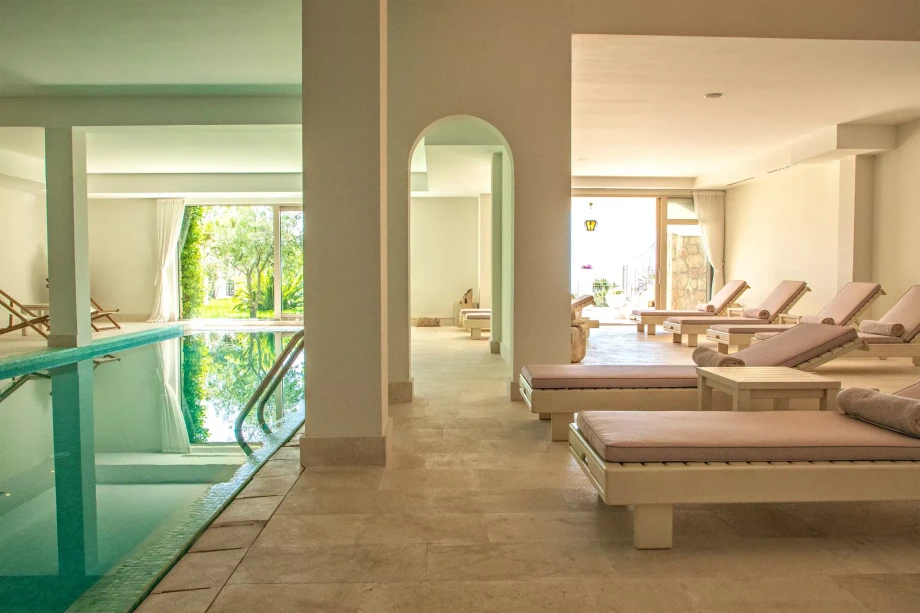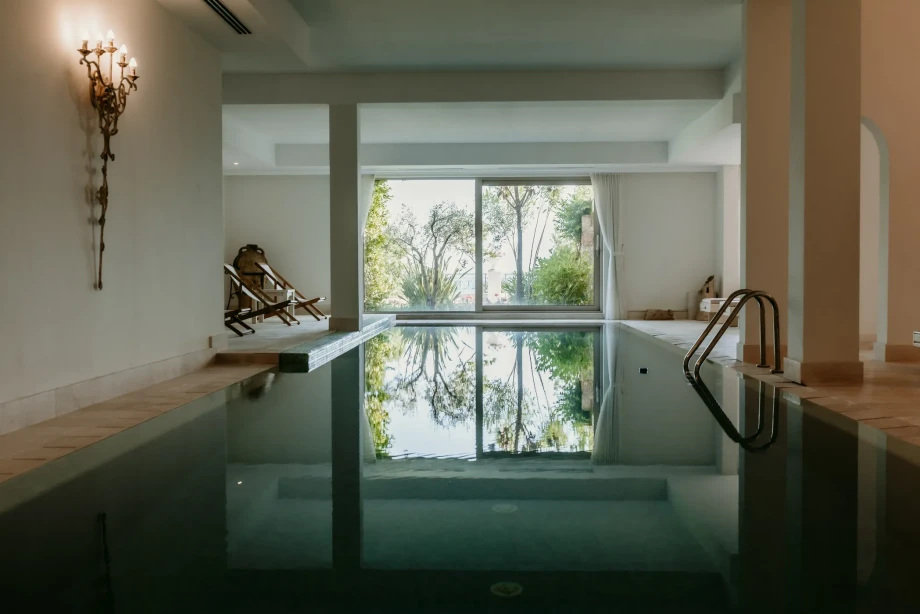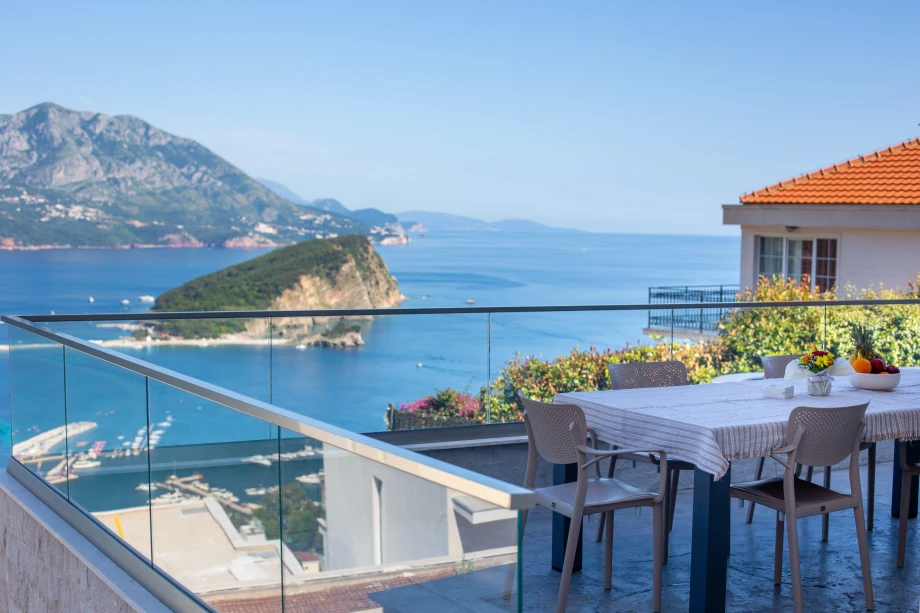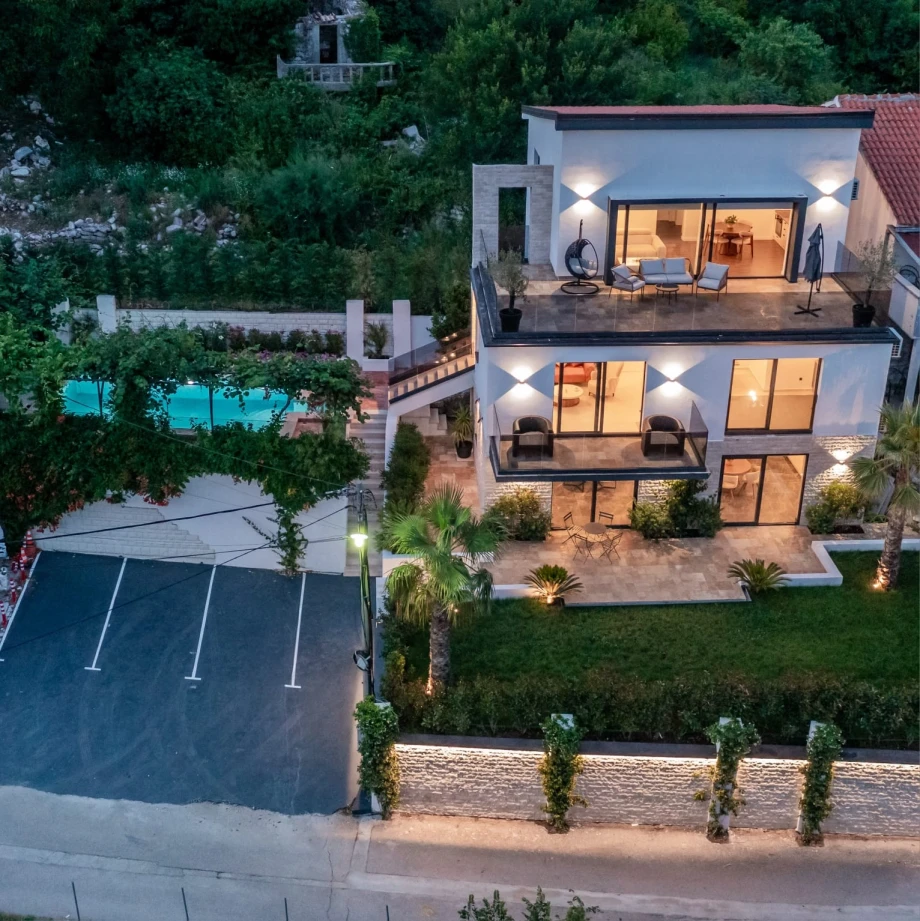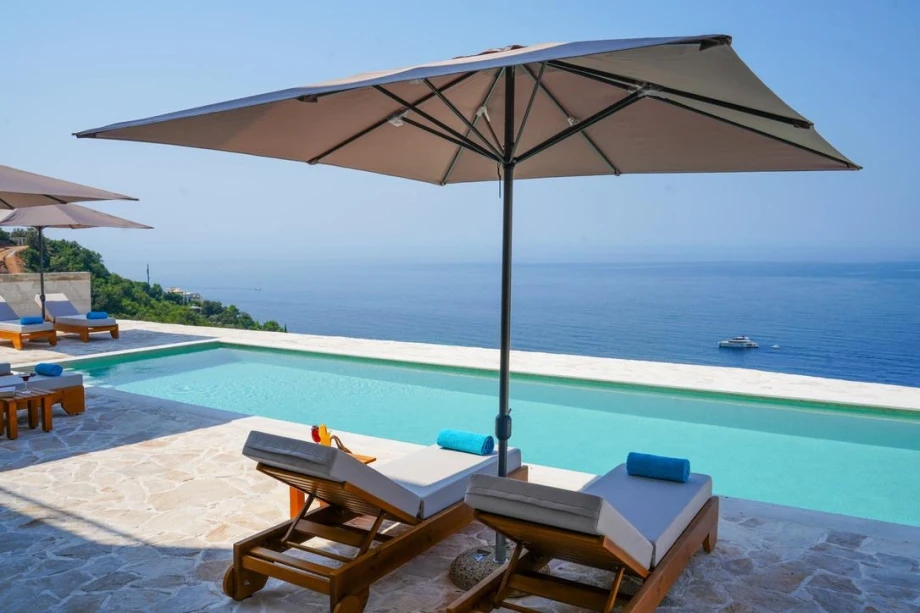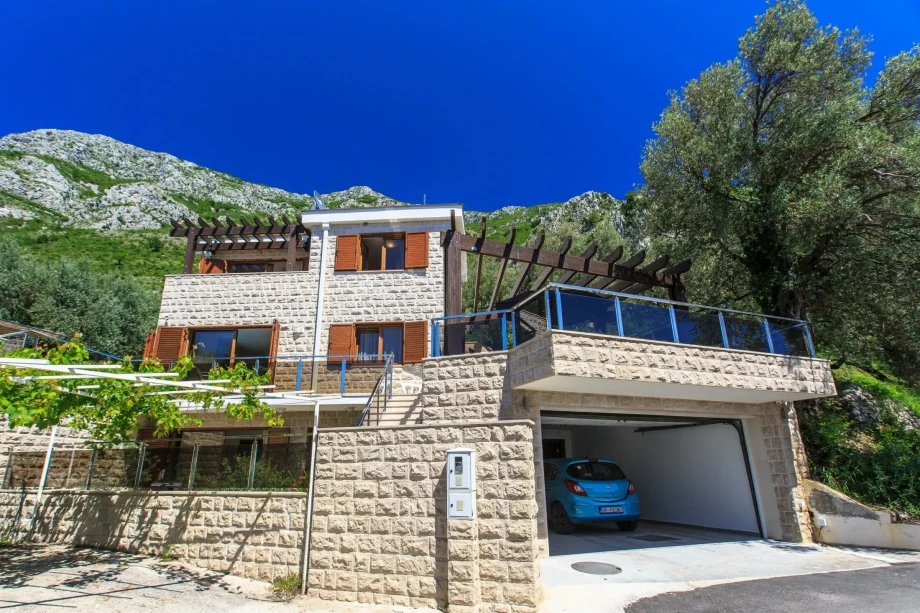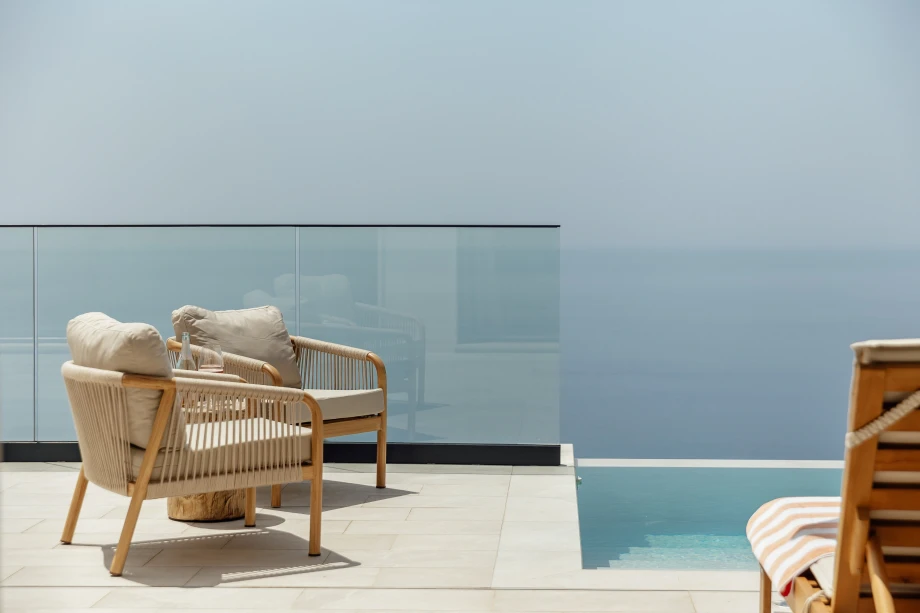

Budva
Luxury Villa Ponta Melagrana with Pool
Villa in Pržno (Budva Area), Montenegro Coastline
Overview
Villa Ponta Melagrana is a luxurious 5-star property located in the prestigious Sveti Stefan area of Budva, Montenegro. Perched atop the Pomegranate cliff in the quaint fishing village of Pržno, this exclusive villa offers unparalleled views of the Adriatic Sea, the Sveti Stefan peninsula, and Sveti Nikola Island.
Amenities & Facilities
Here you will find a comprehensive display of amenities and facilities that the villa of your choice has. Let us know if we can provide anything else for you.
Amenities
General
- Wi-Fi
- High speed Wi-Fi (info +50 MB/s)
- Fully Equipped Kitchen
- Smart TV
- Air Conditioning
Pool & Wellness
- Private
- Indoor
- Outdoor
- Massage Room
- Hot Tub
- Sauna
- Sun Loungers
- Sun Umbrellas
- Hydro Massage
- Hairdryer
Living & Dining
- Sofa
- Armchairs
- Smart TV
- Indoor Dining Area
Garden & Terrace
- Outdoor furniture
- Garden
- Lounge Set
Kitchen
- Kitchen utensils
- Cutlery&Drinks
- Fridge&Freezer
- Oven
- Stove
- Microwave
- Dishwasher
- Coffee machine
- Kettle
Housekeeping
- Washing machine
- Iron and board
- Premium linens&towels
- Towels
Health & Safety
- Quiet area
Outdoor activities
- Watersports nearby
- Walking/Hiking Paths
- Fishing nearby
- Kayak nearby
View
- Sea View
Spa
- Beach umbrellas
- Beach chairs/Loungers
Location & Area
See the map below for exact location of your villa, access roads and the nearby attractions.
Distances
Budva
Extensive archaeological evidence places Budva among the oldest urban settlements of the Adriatic coast. Substantial documentary evidence provides historical references dating back to the 5th century BC.
Illyrian helmet from Budva (4th century BC)
The Old town in 1615.
A legend recounts that Bouthoe (Βουθόη - Bouthoē) was founded by Cadmus, the founder of Thebes, Greece, when exiled out of Thebes, finding a shelter in this place for him and his wife, goddess Harmonia.
Greek colonization of Adriatic began in the 4th century BC, when an Emporium was established on the site of Budva. In the 2nd century BC, the area of Budva became part of the Roman Empire. Upon the fall of the Empire and its division into east and west, the defensive barrier which separated the two powers happened to run across this area, subsequently making a lasting impact on the history and culture of this town.
In the 6th century, Budva was part of the Byzantine Empire, and in the following two centuries, Slavs and, to a lesser extent, Avars began to arrive in the area, mixing with the native Roman population. Budva bay was reportedly known as Avarorum sinus (Avar bay') during the Avar incursions. In 841, Budva was sacked by Muslim Saracens, who devastated the area.
In the early Middle Ages, Budva was reigned by a succession of Doclean kings, as well as Serbian and Zetan aristocrats.
The Venetian walls of Budua (Budva) on a 1900 postcard
Circa 1200, it became the see of a Roman Catholic Diocese of Budua, which lasted until 1828 and was nominally revived as a Latin titular bishopric. The Venetians ruled the town for nearly 400 years, from 1420 to 1797. Budva, called Budua in those centuries, was part of the Venetian Republic region of Albania Veneta and was fortified by powerful Venetian walls against Ottoman conquests. According to the historian Luigi Paulucci in his book "Le Bocche di Cattaro nel 1810" (The Bay of Kotor in 1810), most of the population spoke the Venetian language until the beginning of the 19th century. One of the most renowned theater librettists and composers, Cristoforo Ivanovich, was born in Venetian Budua.
With the fall of Republic of Venice in 1797, Budva came under the rule of the Habsburg Monarchy. During the Napoleonic Wars, Montenegrin forces allied with Russia took control over the city in 1806, only to relinquish the city to France in 1807. French rule lasted until 1813, when Budva (along with Boka Kotorska) was ceded to the Austrian Empire, which remained in control of the city for the next 100 years.
A union of Boka Kotorska (and Budva) with Montenegro took place for a brief period (1813–1814), but from 1814 until the end of World War I in 1918, Budva remained under Austria-Hungary. The southernmost fortress in the Austro-Hungarian empire, Fort Kosmač, was constructed nearby to guard the road from Budva to Cetinje. After the war, the Serbian army entered Budva after it was abandoned by Austrian forces and it came under the Kingdom of Yugoslavia.
In 1941, with the beginning of World War II, Budva was annexed by the Kingdom of Italy. Budva was finally liberated from Axis rule on 22 November 1944 and incorporated in the Socialist Republic of Montenegro (which was a part of the Socialist Federal Republic of Yugoslavia).
A catastrophic earthquake struck Budva on 15 April 1979. Much of old town was devastated, but today there is little evidence of the catastrophe – almost all the buildings were restored to their original form.
Montenegro became an independent country in 2006, with Budva as its primary tourist destination.
Sveti Stefan Island
Sveti Stefan is an iconic island located on the Adriatic coast of Montenegro. The island is situated in the Budva Riviera, a stretch of the Montenegrin coastline famous for its picturesque beaches, clear waters, and historical landmarks. Sveti Stefan is a unique and idyllic location that has captured the hearts of many visitors over the years, and continues to be a must-visit destination for anyone visiting Montenegro.
History of Sveti Stefan
Sveti Stefan's history dates back to the 15th century when it was first mentioned in historical records. At that time, the island served as a fishing village, but it was later transformed into a fortified town to protect it from pirate attacks. During the 20th century, Sveti Stefan became a popular tourist destination and was frequented by many famous people, including movie stars and politicians. In the 1960s, the island was converted into an exclusive hotel, which has since become one of the most sought-after hotels in the world.
Geography of Sveti Stefan
Sveti Stefan is a small island located off the coast of Montenegro. It is connected to the mainland by a narrow isthmus, which gives the island its unique shape. The island itself is only 12,400 square meters in size and is home to a medieval fortress and a charming fishing village. The island's beaches are known for their crystal-clear waters and pristine white sand, making it a popular destination for sun-seekers.
Culture and Tourism in Sveti Stefan
Sveti Stefan is a cultural hub in Montenegro, as it boasts a rich history and a unique charm that draws visitors from around the world. The island's medieval fortress is a testament to its past, and visitors can explore its narrow streets, old buildings, and historic landmarks. The fishing village on the island is a fascinating place to visit, as it is home to many traditional Montenegrin houses, which are built from stone and have red-tiled roofs.
Tourism is the primary industry on the island, and visitors can enjoy a wide range of activities, including swimming, sunbathing, and water sports. The island's hotels offer luxury accommodation and exceptional service, making it an ideal destination for those seeking a high-end vacation experience. Visitors can also take boat tours to explore the nearby coves and bays, or visit the nearby town of Budva, which is known for its vibrant nightlife and cultural attractions.
Conclusion
Sveti Stefan is a jewel of Montenegro, a destination that combines history, culture, and natural beauty in a unique and captivating way. The island's small size belies its significance, as it has played an important role in the country's history and continues to be a popular destination for visitors from around the world. Whether you're looking for a quiet getaway or an adventure-filled vacation, Sveti Stefan has something for everyone, making it a must-visit destination for anyone travelling to Montenegro.
Grad Teater Budva - Theatre City Budva
The Grad Teater Budva Theatre City Budva is an annual festival that celebrates culture and the arts in the city of Budva, Montenegro. The festival has a long and rich history, having been established in the 1980s as a platform for artists and performers to showcase their talents and promote the cultural heritage of Budva. Today, the festival is one of the most important cultural events in Montenegro, attracting visitors from around the world and providing a platform for artists to showcase their work.
History of Grad Teater Budva Theatre City Budva
The Grad Teater Budva Theatre City Budva festival was first held in 1987 and has since become an integral part of the cultural landscape of Montenegro. The festival was established with the goal of promoting the cultural heritage of Budva and providing a platform for artists and performers to showcase their talents. Over the years, the festival has grown in popularity and has become one of the most important cultural events in the country.
Milestones and Plays
The festival features a wide range of performances, including plays, dance performances, and music concerts. The festival is held in various venues throughout Budva, including theaters, parks, and public squares. The festival's program changes every year, and visitors can expect to see a diverse range of performances that reflect the cultural diversity of Montenegro.
Some of the milestone plays in the history of the festival include "The Death of Smail Aga Cengic" by Dusan Kovacevic and "The Bald Soprano" by Eugene Ionesco. Other notable performances have included traditional Montenegrin dances, modern dance performances, and music concerts featuring both local and international musicians.
Impact on Culture and Tourism
The Grad Teater Budva Theatre City Budva festival has had a significant impact on the culture and tourism of Montenegro. The festival has become an important platform for artists and performers to showcase their work and has helped to promote the cultural heritage of Budva. The festival has also attracted visitors from around the world, helping to boost the local economy and promoting the city as a cultural destination.
In addition to its cultural impact, the festival has also played an important role in promoting tourism in Budva. The festival attracts visitors from around the world, many of whom stay in the city for several days or more. This has helped to boost the local economy, and has led to the development of a thriving tourism industry in Budva.
Conclusion
The Grad Teater Budva Theatre City Budva festival is a celebration of culture and the arts in Montenegro. The festival's long and rich history, diverse program of performances, and significant impact on the culture and tourism of Budva make it one of the most important cultural events in the country. For anyone interested in experiencing the rich cultural heritage of Montenegro, the Grad Teater Budva Theatre City Budva festival is not to be missed.
Tivat Airport
Tivat Airport (Serbian: Аеродром Тиват, romanized: Aerodrom Tivat) (IATA: TIV, ICAO: LYTV) is an international airport serving the Montenegrin coastal town of Tivat and the surrounding region.
Airport website| Departure Airport | Airline | Mo | Tu | We | Th | Fr | Sa | Su |
|---|---|---|---|---|---|---|---|---|
| Istanbul, Turkey |

|
|||||||
| Paris, France |

|
|||||||
| Copenhagen, Denmark |

|
|||||||
| Oslo, Denmark |

|
|||||||
| Manchester, United Kingdom |

|
|||||||
| London, United Kingdom |

|
|||||||
| Bristol, United Kingdom |

|
|||||||
| Birmingham, United Kingdom |

|
|||||||
| Vienna, Austria |

|
|||||||
| Berlin, Germany |

|
|||||||
| Frankfurt, Germany |

|
|||||||
| Munich, Germany |

|
|||||||
| Düsseldorf, Germany |

|
|||||||
| Geneva, Switzerland |

|
|||||||
| Zurich, Switzerland |

|
|||||||
| Dubai, United Arab Emirates |

|
|||||||
| Tel Aviv, Israel |

|
|||||||
| Kuwait, Saudi Arabia |

|
|||||||
| Nikola Tesla, Serbia |

|
|||||||
| Baku, Azerbaijan |

|
|||||||
| Barcelona, Spain |

|
|||||||
| Riga, Latvia |

|
|||||||
| Helsinki, Finland |

|
Podgorica Airport
Podgorica Airport (also known as Golubovci Airport; IATA: TGD, ICAO: LYPG) is located in Golubovci, 12 km south of the Montenegrin capital, Podgorica.
Airport website| Departure Airport | Airline | Mo | Tu | We | Th | Fr | Sa | Su |
|---|---|---|---|---|---|---|---|---|
| Athens, Greece |

|
|||||||
| Belgrade, Serbia |

|
|||||||
| Berlin, Germany |

|
|||||||
| Dortmund, Germany |

|
|||||||
| Brussels, Belgium |

|
|||||||
| Istanbul, Turkey |

|
|||||||
| Ankara, Turkey |

|
|||||||
| Izimir, Turkey |

|
|||||||
| Istanbul, Turkey |

|
|||||||
| Krakow, Poland |

|
|||||||
| Warsaw, Poland |

|
|||||||
| Gdansk, Poland |

|
|||||||
| Katowice, Poland |

|
|||||||
| London, United Kingdom |

|
|||||||
| London, United Kingdom |

|
|||||||
| Vienna, Austria |

|
|||||||
| Vienna, Austria |

|
|||||||
| Budapest, Hungary |

|
|||||||
| Milan, Italy |

|
|||||||
| Paris, France |

|
Dubrovnik Airport
Dubrovnik International Airport (IATA: DBV, ICAO: LDDU) is one of the largest international airports in Croatia. The airport is located in Čilipi, 13 km south of the old town of Dubrovnik.
Airport website| Departure Airport | Airline | Mo | Tu | We | Th | Fr | Sa | Su |
|---|---|---|---|---|---|---|---|---|
| Amsterdam, Netherlands |

|
|||||||
| Rotterdam, Netherlands |

|
|||||||
| Amsterdam, Netherlands |

|
|||||||
| Athens, Greece |

|
|||||||
| Athens, Greece |

|
|||||||
| Barcelona, Spain |

|
|||||||
| Madrid, Spain |

|
|||||||
| Berlin, Germany |

|
|||||||
| Düsseldorf, Germany |

|
|||||||
| Frankfurt, Germany |

|
|||||||
| Munich, Germany |

|
|||||||
| Hamburg, Germany |

|
|||||||
| Cologne, Germany |

|
|||||||
| Birmingham, United Kingdom |

|
|||||||
| Bristol, United Kingdom |

|
|||||||
| Edinburgh, United Kingdom |

|
|||||||
| London, United Kingdom |

|
|||||||
| Manchester, United Kingdom |

|
|||||||
| London, United Kingdom |

|
|||||||
| London, United Kingdom |

|
|||||||
| Bordeaux, France |

|
|||||||
| Paris, France |

|
|||||||
| Marseille, France |

|
|||||||
| Nantes, France |

|
|||||||
| Paris, France |

|
|||||||
| Paris, France |

|
|||||||
| Lyion, France |

|
|||||||
| Lyon, France |

|
|||||||
| Copenhagen, Denmark |

|
|||||||
| Dublin, Ireland |

|
|||||||
| Belfast, Ireland |

|
|||||||
| Dublin, Ireland |

|
|||||||
| Rome, Italy |

|
|||||||
| Naples, Italy |

|
|||||||
| Milan, Italy |

|
|||||||
| Helsinki, Finland |

|
|||||||
| Helsinki, Finland |

|
|||||||
| Helsinki, Finland |

|
|||||||
| Istanbul, Turkey |

|
|||||||
| Oslo, Norway |

|
|||||||
| Oslo, Norway |

|
|||||||
| Prague, Czech Republic |

|
|||||||
| Riga, Latvia |

|
|||||||
| Warsaw, Poland |

|
|||||||
| Warsaw, Poland |

|
|||||||
| Krakow, Poland |

|
|||||||
| Wroclaw, Poland |

|
|||||||
| Zürich, Switzerland |

|
|||||||
| Geneva, Switzerland |

|
|||||||
| Vienna, Austria |

|
|||||||
| Dubai, United Arab Emirates |

|
|||||||
| Split, Croatia |

|
|||||||
| Zagreb, Croatia |

|
|||||||
| Vienna, Australia |

|
|||||||
| Gothenburg, Sweden |

|
Tirana Airport
Mother Teresa Tirana International Airport (IATA: TIA, ICAO: LATI) . It is the largest and only international airport in Albania.
Airport website| Departure Airport | Airline | Mo | Tu | We | Th | Fr | Sa | Su |
|---|---|---|---|---|---|---|---|---|
| Vienna, Austria |

|
|||||||
| Vienna, Austria |

|
|||||||
| London, United Kingdom |

|
|||||||
| London, United Kingdom |

|
|||||||
| Edinburgh, United Kingdom |

|
|||||||
| Barcelona, Spain |

|
|||||||
| Madrid, Spain |

|
|||||||
| Valencia, Spain |

|
|||||||
| Paris, France |

|
|||||||
| Lyon, France |

|
|||||||
| Nice, France |

|
|||||||
| Paris, France |

|
|||||||
| Paris, France |

|
|||||||
| Marseille, France |

|
|||||||
| Nantes, France |

|
|||||||
| Bordeaux, France |

|
|||||||
| Warsaw, Poland |

|
|||||||
| Wroclaw, Poland |

|
|||||||
| Krakow, Poland |

|
|||||||
| Gdansk, Poland |

|
|||||||
| Poznan, Poland |

|
|||||||
| Istanbul, Turkey |

|
|||||||
| Antalya, Turkey |

|
|||||||
| Antalya, Turkey |

|
|||||||
| Izmir, Turkey |

|
|||||||
| Berlin, Germany |

|
|||||||
| Frankfurt, Germany |

|
|||||||
| Munich, Germany |

|
|||||||
| Hamburg, Germany |

|
|||||||
| Leipzig, Germany |

|
|||||||
| Nuremberg, Germany |

|
|||||||
| Cologne, Germany |

|
|||||||
| Stuttgart, Germany |

|
|||||||
| Stuttgart, Germany |

|
|||||||
| Budapest, Hungary |

|
|||||||
| Budapest, Hungary |

|
|||||||
| Brussels, Belgium |

|
|||||||
| Milan, Italy |

|
|||||||
| Turin, Italy |

|
|||||||
| Verona, Italy |

|
|||||||
| Milan, Italy |

|
|||||||
| Trieste, Italy |

|
|||||||
| Genoa, Italy |

|
|||||||
| Pisa, Italy |

|
|||||||
| Perugia, Italy |

|
|||||||
| Rome, Italy |

|
|||||||
| Rome, Italy |

|
|||||||
| Naples, Italy |

|
|||||||
| Bari, Italy |

|
|||||||
| Bari, Italy |

|
|||||||
| Catania, Italy |

|
|||||||
| Comiso, Italy |

|
|||||||
| Stockholm, Sweden |

|
|||||||
| Zürich, Switzerland |

|
|||||||
| Geneva, Switzerland |

|
|||||||
| Basel, Switzerland |

|
|||||||
| Athens, Greece |

|
|||||||
| Athens, Greece |

|
|||||||
| Athens, Greece |

|
|||||||
| Lisbon, Portugal |

|
|||||||
| Riga, Latvia |

|
|||||||
| Abu Dhabi, United Arab Emirates |

|
|||||||
| Dubai, United Arab Emirates |

|
|||||||
| Prague, Czech Republic |

|
|||||||
| Warsaw, Aruba |

|
|||||||
| Heraklion, Aruba |

|
|||||||
| Bucharest, Romania |

|
|||||||
| Zagreb, Croatia |

|
|||||||
| Vilnius, Lithuania |

|
|||||||
| Oslo, Norway |

|
|||||||
| Copenhagen, Denmark |

|
|||||||
| Amsterdam, Netherlands |

|
|||||||
| Newcastle upon Tyne, England |

|
|||||||
| Cork, Ireland |

|
Good to Know
Montenegro is a small but diverse country in the Balkans, situated on the Adriatic coast. It has a rich cultural heritage, stunning natural landscapes, and a warm Mediterranean climate that makes it an ideal destination for vacation. Here are some things that are good to know for a vacation in Montenegro.
-
Best time to visit: Montenegro is a year-round destination, but the best time to visit is from May to October when the weather is warm and sunny, and the beaches are in their full glory.
-
Currency: The official currency of Montenegro is the Euro (EUR), which is widely accepted in shops, restaurants, and hotels. ATMs are widely available in major cities and tourist areas.
-
Language: The official language of Montenegro is Montenegrin, but most people also speak Serbian, Croatian, and English, especially in tourist areas.
-
Transportation: Montenegro has a good network of buses that connect all major cities and towns. Taxis are also available, but it's always advisable to agree on a fare before getting in. Renting a car is a good option for exploring the country's rugged terrain.
-
Accommodation: Montenegro has a wide range of accommodation options to suit all budgets, from luxury hotels to budget hostels. During peak season, it's advisable to book in advance.
-
Cuisine: Montenegrin cuisine is a mix of Mediterranean and Balkan flavors. Seafood, grilled meat, and local vegetables are staples of the cuisine. Rakija, a strong fruit brandy, is a popular drink.
-
Beaches: Montenegro has some of the most beautiful beaches on the Adriatic coast. Some of the most popular ones include Sveti Stefan, Budva, and Kotor Bay.
-
National parks: Montenegro is home to five national parks, each with its unique natural beauty. Durmitor National Park, Biogradska Gora National Park, and Skadar Lake National Park are some of the most popular ones.
-
Cultural attractions: Montenegro has a rich cultural heritage, with influences from the Illyrian, Roman, and Ottoman empires. The Old Town of Kotor, Ostrog Monastery, and Cetinje are some of the most popular cultural attractions.
-
Safety: Montenegro is a safe country for tourists. However, it's always advisable to take basic precautions like not leaving valuables unattended and being aware of your surroundings, especially in crowded areas.
Availability Calendar
Extras
Transfer from Podgorica Airport to the Villa includes a 7-seater luxury class passenger van.
Transfer from Tivat Airport to the Villa includes a 7-seater luxury class passenger van.
Transfer from Dubrovnik Airport to the Villa includes a 7-seater luxury class passenger van.
Small SUV for 5 persons (Audi Q3, BMW X1, Volkswagen Tiguan, Renault Kadjar...)
Accommodation Policy
- Check-in: 14:00 h
- Check-out: 11:00 h
- Max guests: 22
- Pets: Allowed
- Smoking: Not Allowed
- Large Gatherings: Allowed
Moderate
| Before checkin | Refundable | Advance Payment |
|---|---|---|
| 0 - 14 days | 0% | 100% |
| 15 - 29 days | 20% | 100% |
| 30 - 365 days | 0% | 40% |
| 30 - 365 days | 60% | 100% |
Guest cancels 30+ days before arrival: 40% (advance payment) kept.
Guest cancels between 29-15 days before arrival: 80% (advance payment) kept
Guest cancels 14 or less days before arrival: 100% (advance payment) kept
Weddings and other celebrations upon request
Make a Reservation

Villa Expert
Azra Ševaljević
I will help make all your needs for an exquisite vacation happen.
Like this property?
Continue your search
Add extras to your Reservation

Villa Expert
Azra Ševaljević
I will help make all your needs for an exquisite vacation happen.
